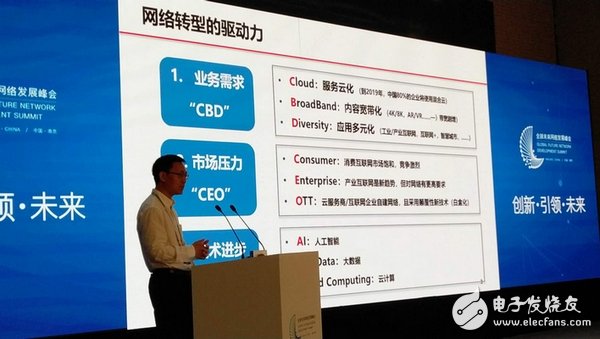The data shows that in 2017, the total volume of China's telecom services increased by 76.4% year-on-year, and the revenue of telecom services increased by 6.4% year-on-year. The effect of the volume-receiving scissors is obvious. The transformation has become an inevitable requirement for the sustainable development of the telecom industry. On the one hand, the ICT business has increased revenue, and another On the one hand, CAPEX and OPEX are reduced through network innovation. Network transformation is already urgent for operators.
At the Global Future Network Summit “SDN and NFV Sub-Forum†held on May 12th, Tang Xiongyan, chief expert of China Unicom Network and Technology Research Institute, said that China Unicom’s network transformation work will focus on six aspects in the future. By 2025, China Unicom The proposed new generation network CUBE-Net 2.0 and intelligent and intensive network operation system will be fully completed, and the network software and virtualization ratio will reach over 90%.

In Tang Xiongyan's view, service cloudization, content broadband, application diversification and market pressures, as well as advances in technologies such as artificial intelligence, big data, and cloud computing have become important drivers of network transformation. In this context, Tang Xiongyan said that the characteristics of China Unicom's network transformation are mainly reflected in three aspects: First, the network technology is IT, and the technology of “ABC†should be introduced; Second, the customized and differentiated services of network products; Third, network services. E-commerce. In this regard, China Unicom will strengthen the top-level design, based on a unified technical architecture, guided by market demand, to achieve partial breakthroughs.
At the same time, Tang Xiongyan also introduced the medium and long-term goals of China Unicom's development of CUBE-Net2.0. By 2020, in the construction of communication cloud and NFV, the resource pool of Unicom's unified communication cloud is basically completed, and the new mobile core network element is fully virtualized and clouded. At the same time, the 5G network infrastructure is ready; in terms of network SDN, Complete the SDN transformation of IP A network and IP RAN, and basically build an end-to-end SDN industry Internet network (CUII) to realize cloud-based cloud network integration service; in the new operation support, initially build a new generation of intelligent, automated The open network service system introduces AI and initially realizes intelligent operation and maintenance.
By 2025, the new network CUBE-Net 2.0 and the intelligent and intensive network operation system will be fully established. The proportion of network software and virtualization will reach over 90%. The network's independent integration and R&D capabilities will be greatly enhanced. Service, the Internet of Everything and the scale of 5G development.
Six major points of network transformationAccording to Tang Xiongyan, China Unicom's network transformation will focus on six aspects: one is SDN-based cloud network collaboration; the other is NFV-based cloud core network (vEPC, vIMS); the third is metropolitan area network reconfiguration vBRAS and edge cloud MEC; Fourth, a unified communication cloud infrastructure; Fifth, operational automation and intelligence; Sixth, the construction of 5G networks.
In terms of SDN, the IP A network is upgraded to build an industrial Internet backbone and serve cloud network collaboration. In 2018, the expansion of the industrial Internet A network coverage: 334 cities and cities all support SDN, 45 new SDN coverage points overseas, and the end-to-end service provisioning is shortened to the minute level to achieve full docking IP RAN; The transformation of SDN will also gradually extend to the metropolitan area network.
In terms of communication cloud construction, because the communication cloud is the technology of the entire network transformation, the future network is a DC-centric network system. China Unicom's DC transformation is divided into three levels, dozens of provincial-level regional DC+ hundreds of places. City core computer room, core node computer room + thousands of edge DC. China Unicom's communication cloud construction adheres to the adoption of a three-layer decoupling model, the construction of a unified cloud resource pool, and the deployment of multi-service common platforms. The first-level architecture and centralized management realize “three unifications and one collaborationâ€, in which the infrastructure is managed by VIM, PIM and unified cloud management platform, the network elements are managed by VNFM and EMS, the network is managed by NFVO, and NFVO and OSS cooperate with each other. Realize the unified management of traditional networks and virtual networks.
In terms of mobile core network construction, China Unicom's basic strategy is that the new network elements must be done in an open manner, and then gradually replaced, and the 5G core network elements are fully clouded.
In the construction of metropolitan area network, vBRAS is the starting point to promote the reconstruction of metropolitan area network. The development idea is that the virtualization route is the main, the forwarding surface is integrated with switches, and the cost is reduced. From 2018 to 2019, the incremental BRAS adopts virtualization and stock BRAS to maintain the status quo; after 2020, it is deployed with 5G vEPC to achieve solid-mobile convergence. Cloudized metropolitan area network.
In the construction of the edge cloud MEC, a three-tier architecture of the site equipment room, the integrated access equipment room, and the edge DC is formed to provide differentiated services and services to users at the edge network location, enabling low-latency, high-bandwidth services; OTT and industry. The client's application is deployed at the edge, using the open API to provide a variety of services using the edge platform.
In terms of CORD exploration, China Unicom actively participated in the open source project CORD, became the only Chinese operator of the ONF/CORD board of directors, and launched the China CORD Industry Alliance to build the first domestic M-CORD telecom edge open platform based on CORD 4.1.
Air Bar,Disposable Vape Air Bar,Air Bar Disposable Vape Pod,Air Bar Light Edition
Shenzhen Zpal Technology Co.,Ltd , https://www.zpal-vape.com
